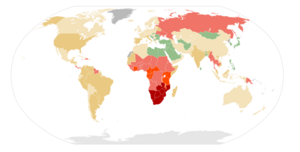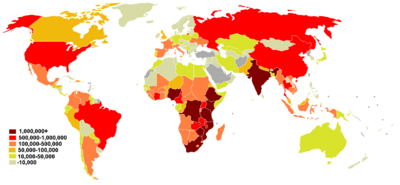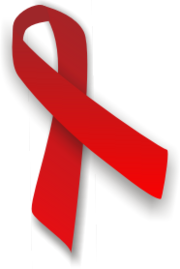HIVAIDS/Overview
HIV/AIDS
- Introduction to HIV/AIDS
- Overview of HIV/AIDS
- Health Promotion and Prevention of HIV
- HIV the virus
- AIDS and Opportunistic Infections
- Legal, Ethical, Moral Issues
- Mental Health and Spirituality
- Issues for Women and Children
- Sex workers and Intravenous Drug Users
- The face of HIV/AIDS
- Care of people with HIV/AIDS
- Community support and alternative therapies
- Critiquing literature and poster assignment
- Assessments
- Picture Gallery
Overview of HIV/AIDS
Overview and Objectives
Global and national beginnings of HIV/AIDS will be covered in this topic. Participants will gain an appreciation of the difficulties of pinpointing a specific date when the virus was first recognised. Participants will journey more specifically in a time line from the early eighties to the present time.
To do
- View the presentation about the History of HIV/AIDS. Click the full-screen icon at the bottom right of the presentation to make it bigger.
- Explore the material for this topic.
- Attend an online Elluminate session via the Class meeting link on 13 May 2009 NZST, from 16.00 to 17.00.
- This session is about library services which are available for remote students, and you will be given an introduction to accessing digital information and library databases.
- You need to test the link a few days before and contact the Student IT Service Desk if you have any problems.
- You will need a headset with microphone if this is not built in to your computer.
- When you log in add your name only - NO password is needed.
- Attend an online Elluminate session via the Class meeting link on 13 May 2009 NZST, from 16.00 to 17.00.
History of AIDS

The AIDS epidemic was first recognised in the United States in early 1981. Doctors in Los Angeles, San Francisco and New York realised that a new disease was killing homosexual men. These men all had at least one unusual infection, for example pneumonia due to Pneumocystis carinii, or mouth or oesophageal infection due to Candida albicans. Many men also had unusual cancers, especially Kaposi’s sarcoma, a rare skin cancer. The infections were similar to those seen in patients with severe immune deficiencies but the men with AIDS did not have any of the unusual reasons for severe immune deficiency, such as treatment to prevent rejection of an organ transplant or treatment for cancer.
Causes
A variety of causes for the severe immune deficiency were suspected including overload of the immune system by repeated exposure to semen or other body fluids, infection with cytomegalovirus, and/or inhalation of amyl nitrate and other commonly used recreational drugs. However the recognition that AIDS also developed in haemophiliacs, injection drug users or partners of bisexual men strongly suggested that the illness was caused by an infection transmitted in blood or body fluids such as semen. About the same time it was found that many of the first patients to develop AIDS in the United States had had sex with other men with the disease and this provided further evidence that AIDS is due to a sexually transmitted infection.
Following the recognition that AIDS was affecting homosexual men in large cities in the United States the disease was seen in homosexual men in many other cities such as London, Amsterdam and Sydney. Within a year of the death of the first people with AIDS the homosexual communities in these cities became concerned about how to prevent further cases. Despite arguments from some against giving up newly won freedoms homosexual men started to have fewer sexual partners and to use condoms in the hope that this would stop the spread of the infection suspected to be responsible for AIDS.
Recognising the virus, testing and diagnosis
IN 1983 scientists in Paris reported that they had grown a new virus in the lymph node of a man who had an illness suggestive of early AIDS. In 1984 scientists in Washington, DC, reported that they had grown a virus from the blood or tissues from 48 men who either had AIDS or illnesses recognised to precede AIDS. The American scientists went further and developed a test which could diagnose infection with the virus by detecting antibodies against the virus in the blood of an infected person. A scandal erupted when it was claimed that the virus discovered by the American scientists (which they called Human T-cell Lymphotropic Virus type III or HTLV III) had been stolen from the French scientists (who had called the virus Lymphadenopathy Associated Virus, or LAV).
By the middle of 1985 the technology required to test blood for antibodies to the virus was widely available and it became possible to diagnose HIV (Human Immono- deficiency Virus) infection. Routine testing of blood and organ donors was quickly introduced. Unfortunately it was too late for very many patients. Approximately 50% to 70% of haemophiliacs had already been infected through the use of contaminated clotting factors and many other patients had been infected when they were given blood transfusions, organ transplants or sperm donations.
The ability to diagnose HIV infections by testing for antibodies to HIV also meant that tests could be performed on specimens of blood or tissues which had been stored for other reasons. It was found that HIV infection had been responsible for the death due to AIDS of a small number of people many years before the disease was first recognised. A young American man had died of AIDS in 1968, a Norwegian sailor and his wife and eight year old child had died of AIDS in 1976, and a Danish surgeon had died of AIDS in 1977. Some of these people were known to have had direct or indirect links with Africa. Antibodies to HIV were also found in samples of blood collected for research in Africa many years earlier. Then when samples of blood which had been collected from homosexual men during trials of a new hepatitis B vaccine in San Francisco, New York, and Amsterdam were tested it was found that very few of the men had HIV infection in 1978 but that almost 30% of them had become infected in 1982.
Treatment
Until 1987 the only useful treatment for HIV infected patients were drugs to cue or suppress the unusual secondary infections. These opportunistic infections such as Pneumocystis carinii pneumonia, Candida albicans pharyngitis and oesophagitis, Toxoplasma gondii brain abscesses and Cryptococcus neoformans meningitis could be treated successfully with antibacterial and antifungal drugs. However nothing was available to slow the replication of HIV in the infected person.

Zidovudine (azidothymidine, AZT), a drug which had been developed as a possible anticancer drug in 1964, was found to be effective against HIV. When given to patients with AIDS, or illnesses which commonly occur shortly before the onset of AIDS, it was found that AZT helped to prevent further opportunistic infections and delay death. Since the variety of other drugs with similar or different mechanisms of action against HIV have been discovered and used as treatments.
Evolution of HIV

Shortly after HIV was discovered it was recognised that it was closely related to other viruses which infect a variety of animals, for example a virus which causes a brain disease in sheep and leukaemia – causing viruses in mice and birds. By 1989 similar viruses had been found in many species of African ape. These Simian (ape) Immunodeficiency Viruses (SIV) usually do not cause any harm to the infected apes presumable because the apes have coexisted with these viruses for thousands of years. HIV1 (the most common strain of HIV) is very similar to the SIV found in chimpanzees while HIV2 (the less common strain of HIV, which is most often found in West African people) is similar to the SIV found in sooty mangabeys.
The worldwide spread of HIV
It seems likely that HIV first evolved in the African people who hunted and killed apes. Some of these people became infected with SIV through contact with infected monkey blood and in these people SIV evolved into HIV a virus better adapted to infect humans and to be transmitted from person to person.
From these people the infection spread to the towns and cities of central Africa. Occasionally the infection was transmitted to people from Europe or America but the epidemic of HIV in the West was not recognised until the infection was introduced into gay communities in New York, San Francisco and Los Angeles. Since then it has spread around the world. In western countries HIV infection is largely a disease of gay men and injecting drug users, while in many third would countries it has spread very widely through the community.
